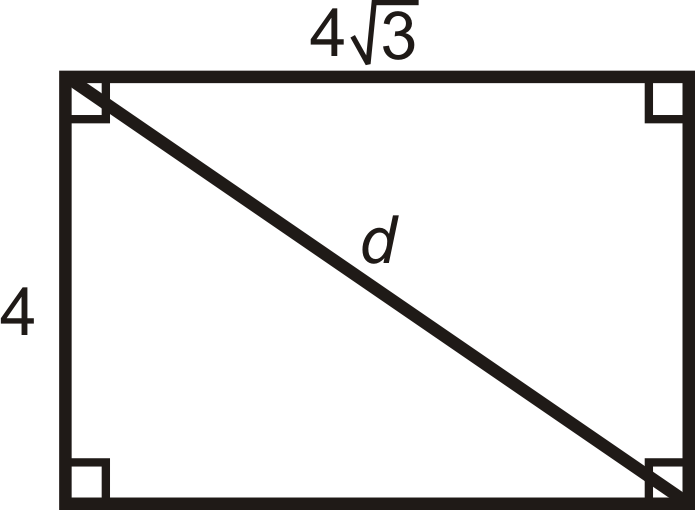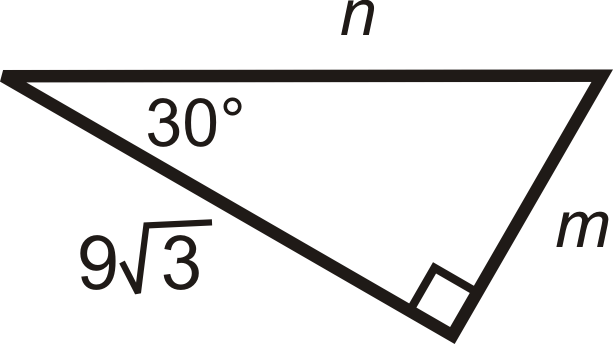1.9: 30-60-90 Right Triangles
- Page ID
- 14089
Hypotenuse equals twice the smallest leg, while the larger leg is \(sqrt{3}\) times the smallest.
One of the two special right triangles is called a 30-60-90 triangle, after its three angles.
30-60-90 Theorem: If a triangle has angle measures \(30^{\circ}\), \(60^{\circ}\) and \(90^{\circ}\), then the sides are in the ratio \(x: x\sqrt{3}:2x\).
The shorter leg is always \(x\), the longer leg is always \(x\sqrt{3}\), and the hypotenuse is always \(2x\). If you ever forget these theorems, you can still use the Pythagorean Theorem.
What if you were given a 30-60-90 right triangle and the length of one of its side? How could you figure out the lengths of its other sides?
Find the value of \(x\) and \(y\).

Solution
We are given the longer leg.
\(\begin{aligned} x\sqrt{3} &=12 \\ x&=12\sqrt{3}\cdot \dfrac{\sqrt{3}}{\sqrt{3}}=12\dfrac{\sqrt{3}}{3}=4\sqrt{3} \\ \text{The hypotenuse is } y&=2(4\sqrt{3})=8\sqrt{3} \end{aligned}\)
Find the value of \(x\) and \(y\).

Solution
We are given the hypotenuse.
\(\begin{aligned} 2x&=16 \\ x&=8 \\ \text{The longer leg is } y&=8\cdot \sqrt{3}&=8\sqrt{3} \end{aligned} \)
Find the length of the missing sides.

Solution
We are given the shorter leg. If \(x=5\), then the longer leg, \(b=5\sqrt{3}\), and the hypotenuse, \(c=2(5)=10\).
Find the length of the missing sides.

Solution
We are given the hypotenuse. \(2x=20\), so the shorter leg, \(f=\dfrac{20}{2}=10\), and the longer leg, \(g=10\sqrt{3}\).
A rectangle has sides 4 and \(4\sqrt{3}\). What is the length of the diagonal?
Solution
If you are not given a picture, draw one.

The two lengths are \(x\), \(x\sqrt{3}\), so the diagonal would be \(2x\), or \(2(4)=8\).
If you did not recognize this is a 30-60-90 triangle, you can use the Pythagorean Theorem too.
\(\begin{aligned} 4^2+(4\sqrt{3})^2&=d^2 \\ 16+48&=d^2 \\ d=\sqrt{64}&=8 \end{aligned}\)
Review
- In a 30-60-90 triangle, if the shorter leg is 5, then the longer leg is __________ and the hypotenuse is ___________.
- In a 30-60-90 triangle, if the shorter leg is \(x\), then the longer leg is __________ and the hypotenuse is ___________.
- A rectangle has sides of length 6 and \(6\sqrt{3}\). What is the length of the diagonal?
- Two (opposite) sides of a rectangle are 10 and the diagonal is 20. What is the length of the other two sides?
For questions 5-12, find the lengths of the missing sides. Simplify all radicals.
-

Figure \(\PageIndex{6}\) -

Figure \(\PageIndex{7}\) -

Figure \(\PageIndex{8}\) -

Figure \(\PageIndex{9}\) -

Figure \(\PageIndex{10}\) -

Figure \(\PageIndex{11}\) -

Figure \(\PageIndex{12}\) -

Figure \(\PageIndex{13}\)
Review (Answers)
To see the Review answers, open this PDF file and look for section 8.6.
Resources
Vocabulary
| Term | Definition |
|---|---|
| 30-60-90 Theorem | If a triangle has angle measures of 30, 60, and 90 degrees, then the sides are in the ratio \(x : x \sqrt{3} : 2x\) |
| 30-60-90 Triangle | A 30-60-90 triangle is a special right triangle with angles of \(30^{\circ}\), \(60^{\circ}\), and \(90^{\circ}\). |
| Hypotenuse | The hypotenuse of a right triangle is the longest side of the right triangle. It is across from the right angle. |
| Legs of a Right Triangle | The legs of a right triangle are the two shorter sides of the right triangle. Legs are adjacent to the right angle. |
| Pythagorean Theorem | The Pythagorean Theorem is a mathematical relationship between the sides of a right triangle, given by \(a^2+b^2=c^2\), where a and b are legs of the triangle and c is the hypotenuse of the triangle. |
| Radical | The \(\sqrt{}\), or square root, sign. |
Additional Resources
Video: Solving Special Right Triangles
Activities: 30-60-90 Right Triangles Discussion Questions
Study Aids: Special Right Triangles Study Guide
Practice: 30-60-90 Right Triangles
Real World: Fighting the War on Drugs Using Geometry and Special Triangles

